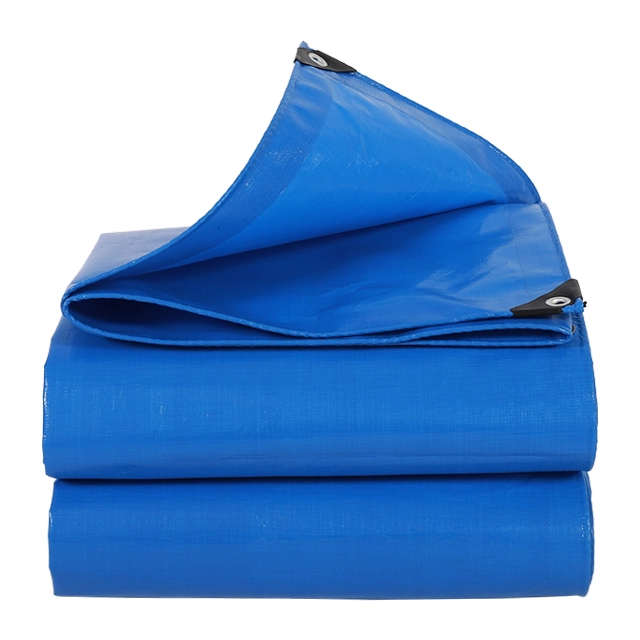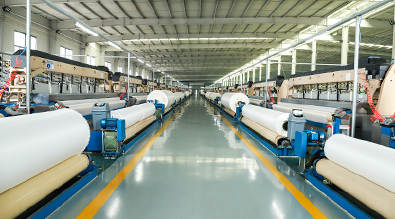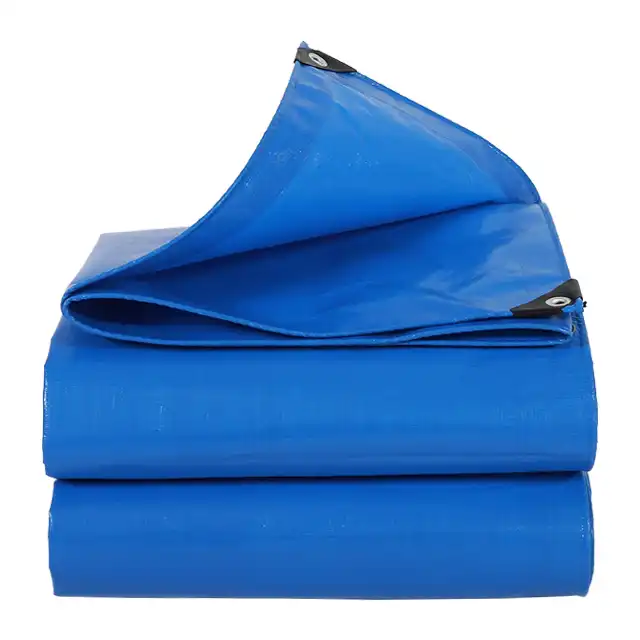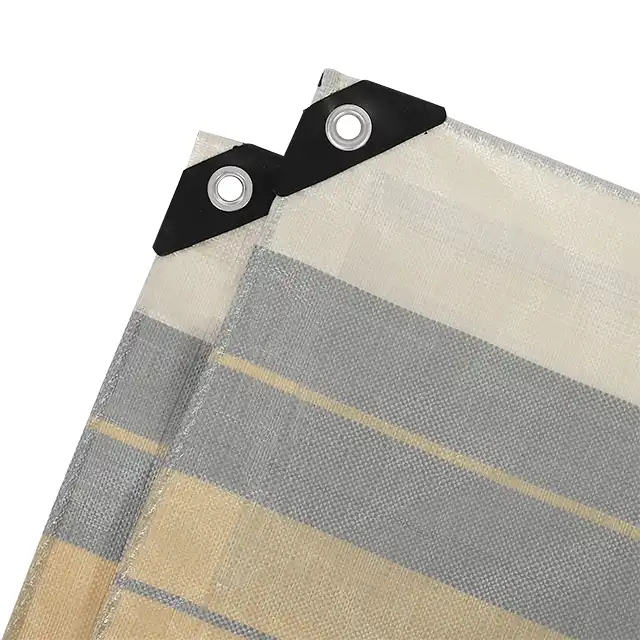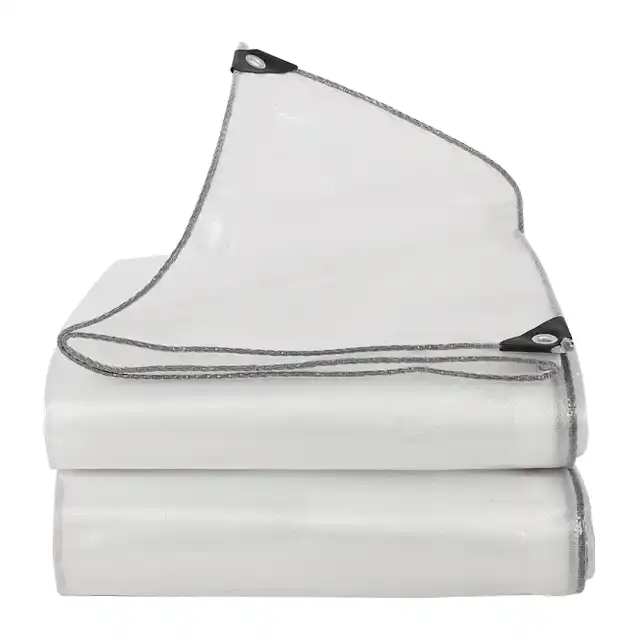Top 5 Heavy-Duty Plastic Tarps for Construction Sites (2025)
Construction sites demand robust protection against the elements, and choosing the right tarp can make the difference between project delays and smooth progress. In 2025, the market offers advanced heavy-duty plastic tarps specifically engineered to withstand the rigors of construction environments. These essential coverings not only shield materials and equipment from rain, sun, and dust but also contribute to site safety and organization. This comprehensive guide explores the top five heavy-duty plastic tarpaulin options available this year, with special attention to plastic tarpaulin rolls that provide superior coverage for large-scale projects. Whether you're managing residential builds or commercial developments, these selections combine durability, versatility, and value to meet the demanding requirements of today's construction professionals.
 Understanding Heavy-Duty Plastic Tarps and Their Construction Applications
Understanding Heavy-Duty Plastic Tarps and Their Construction Applications
Heavy-duty plastic tarps represent a crucial investment for construction site protection and management. Unlike standard tarps, these industrial-grade covers are specifically engineered to withstand extreme conditions while providing reliable protection. The foundation of a superior construction tarp lies in its material composition and manufacturing process. Most premium tarps utilize high-density polyethylene (HDPE) woven fabric with low-density polyethylene (LDPE) coating on both sides, creating a waterproof, tear-resistant barrier.
The best plastic tarpaulin rolls for construction applications feature reinforced edges, heavy-duty grommets, and UV stabilizers that prevent degradation from prolonged sun exposure. Weight measurements ranging from 100gsm to 280gsm (grams per square meter) indicate the thickness and durability, with heavier options providing enhanced protection for the most demanding environments. The mesh count, typically ranging from 10×10 to 14×14, refers to the density of the woven fibers – higher counts generally indicating greater strength and durability.
Construction professionals rely on these tarps for numerous applications, including temporary roofing, concrete curing, equipment protection, debris containment, and weather barriers. The versatility of plastic tarpaulin rolls makes them indispensable, as they can be custom-cut to precise dimensions or deployed in continuous stretches for comprehensive coverage. When selecting the optimal tarp for construction needs, factors such as thickness, UV resistance, tear strength, and temperature tolerance should all be carefully evaluated against the specific demands of the project and local climate conditions.
Top 5 Heavy-Duty Plastic Tarps Dominating Construction Sites in 2025
The construction industry continually evolves, and so does the technology behind protective materials. After extensive research and professional feedback, we've identified the top performers in the heavy-duty tarp category for 2025. These selections represent the pinnacle of durability, versatility, and value for construction applications.
SENDOW Reinforced Multipurpose Tarp leads our list as the premier choice for demanding construction environments. Manufactured by Linyi Shengde Plastic Co., Ltd., these exceptional plastic tarpaulin rolls feature 12-mil thickness and a robust 14×14 mesh count, providing superior tear resistance even under extreme tension. What sets these tarps apart is their specialized UV treatment (up to 7% stabilizer content), ensuring they maintain structural integrity during prolonged outdoor exposure. The middle-duty series offers versatile roll widths up to an impressive 5.1 meters, eliminating the need for seams across most standard construction spans. Construction managers particularly value the arctic flexibility feature, which prevents cracking in cold-weather applications, while the 100% waterproof guarantee provides peace of mind during unexpected weather changes. These tarps undergo rigorous quality control through Shengde's ISO 9001:2015 certified processes, ensuring consistent performance across every foot of material.
The Premium All-Weather Construction Cover represents the next evolution in construction protection technology. These tarps utilize an advanced lamination process that bonds multiple layers of polyethylene to create an exceptionally strong yet flexible covering. The reinforced hems and heat-sealed seams prevent water penetration at vulnerable points, while specialized anti-corrosion treatments protect metal components from rust development when covered. Construction teams appreciate the non-slip texture that reduces hazardous material shifting during wind events. Available in custom dimensions with weights ranging from 150-200gsm, these tarp systems can be precisely matched to specific project requirements without excess material waste.
The Heavy-Duty Contractor Grade Tarpaulin provides exceptional value without compromising essential performance characteristics. These tarps feature specialized corner reinforcements that prevent tearing at high-stress points – a common failure point in lesser products. The material composition incorporates shrink-proof technology that maintains dimensional stability throughout temperature fluctuations, ensuring consistent coverage regardless of conditions. With an integrated mildew resistance treatment, these tarps prevent the development of harmful mold during extended storage of construction materials. The weight range of 100-180gsm strikes an ideal balance between maneuverability and protection capability.
The Ultra-Wide Coverage Construction Tarp System addresses the increasing demand for seamless protection across expansive areas. These plastic tarpaulin rolls can be manufactured up to 5 meters in width without joints, eliminating potential leak points and structural weaknesses. The specialized weaving process creates a tear-resistant grid pattern that redistributes stress forces across the entire surface. Construction professionals particularly value the customizable opacity levels available, allowing precise control of light penetration for concrete curing applications. The waterproof rating exceeds industry standards, ensuring complete protection even during sustained heavy rainfall.
The Eco-Friendly Sustainable Construction Tarp rounds out our top selections as environmental considerations become increasingly important in construction practices. These innovative tarps incorporate recycled polyethylene content without sacrificing durability, reducing the environmental footprint of construction operations. The manufacturing process minimizes harmful emissions while maintaining strict quality standards. Despite the eco-friendly focus, these tarps deliver impressive performance metrics, including excellent tear resistance and UV stability. The material's breathable design prevents condensation buildup under the covered areas while maintaining waterproof integrity from external moisture – a critical feature for protecting sensitive building materials.
Essential Features to Look for in Construction-Grade Plastic Tarpaulins
When investing in heavy-duty plastic tarps for construction applications, certain critical features differentiate exceptional products from merely adequate ones. Understanding these characteristics ensures that project managers select tarps that will perform reliably throughout demanding construction timelines.
Waterproof integrity stands as the most fundamental requirement for any construction tarp. Premium plastic tarpaulin rolls, like those produced by Sendow Tarpaulin, undergo specialized coating processes that create impermeable barriers against moisture. The lamination technique applies LDPE coating to both sides of the HDPE woven fabric, creating multiple defensive layers against water penetration. The best construction tarps maintain this waterproof performance even after repeated folding and deployment, with heat-sealed seams preventing leakage at vulnerable connection points. Construction professionals should verify that tarps carry appropriate waterproof ratings for their specific applications, especially for sensitive materials storage or concrete work.
Tear resistance represents another crucial consideration, as construction environments present numerous opportunities for damage. Superior plastic tarpaulin rolls incorporate high-strength yarns woven in dense patterns (typically 10×10 to 14×14 mesh counts) that distribute stress forces across the entire surface. Reinforced edges, often with double or triple hemming, provide additional strength at common failure points. The most durable options incorporate tear-stop technologies that prevent small punctures from developing into catastrophic failures. When evaluating tear resistance, construction managers should consider both initial strength and performance after UV exposure, as some inferior products may degrade rapidly under sunlight despite impressive initial specifications.
UV protection constitutes an essential feature for construction tarps, as prolonged sun exposure can quickly degrade unprotected materials. Quality manufacturers incorporate UV inhibitors directly into the polymer matrix, providing resistance against harmful sunrays and preventing fading and material breakdown. Premium options like Sendow Tarpaulin's offerings include UV treatment ranging from 1% to 7%, with higher percentages providing extended service life in intense sun conditions. This UV resistance not only preserves the tarp itself but also protects covered materials from solar damage. For projects extending beyond a few weeks, this UV stability factor can prove critical in maintaining effective protection throughout the construction timeline.
Temperature tolerance has gained increasing importance as construction continues year-round in diverse climates. High-performance plastic tarpaulin rolls maintain flexibility and integrity across extreme temperature ranges, with arctic flexibility preventing cracking in cold conditions while heat stabilizers prevent softening or deformation during hot weather. This consistent performance regardless of ambient temperature ensures reliable protection without requiring seasonal material changes. Construction managers in regions with variable climates particularly value this adaptability, as it eliminates the complexity of switching protective systems as seasons change.
Size flexibility allows construction teams to optimize coverage without excessive waste or complicated seaming. Leading manufacturers like Linyi Shengde Plastic Co. offer plastic tarpaulin rolls in widths up to 5.1 meters, allowing continuous coverage across substantial areas. Custom dimensioning capabilities further enhance this flexibility, with made-to-order options accommodating unique project requirements. When evaluating size options, construction professionals should consider both immediate needs and potential future applications, as versatile tarping systems can serve multiple functions throughout various project phases.
Strategic Applications of Heavy-Duty Plastic Tarps on Modern Construction Sites
Modern construction methodologies increasingly rely on strategic tarp deployments to enhance efficiency, safety, and material protection. Understanding these applications helps construction managers maximize the utility of their plastic tarpaulin investments while minimizing project risks.
Weather protection constitutes the most visible application of heavy-duty tarps on construction sites. As unpredictable weather patterns become more common, the ability to quickly deploy comprehensive protection against rain, snow, or excessive sun exposure proves invaluable. Premium plastic tarpaulin rolls from manufacturers like Sendow can be rapidly deployed as temporary roofing systems, vertical weather barriers, or ground covers to prevent water infiltration or mud development. The 100% waterproof nature of these materials ensures that sensitive building components remain protected even during extended precipitation events. Additionally, the UV-resistant properties shield temperature-sensitive materials from solar degradation. Construction managers increasingly incorporate planned tarp deployment into their weather contingency protocols, with dedicated teams and equipment ready to implement protection when forecasts indicate adverse conditions.
Material staging and protection represent another critical application domain. Construction sites require organized storage areas for building materials, and heavy-duty tarps provide ideal segregation and protection solutions. The tear-resistant properties of premium plastic tarpaulin rolls allow them to withstand the rigors of material handling operations, while their waterproof nature keeps valuable supplies in optimal condition. Custom-sized tarps can create designated storage zones with clear visual boundaries, enhancing site organization and inventory management. The anti-corrosion features protect metal components from rust development, while the shrink-proof characteristics ensure consistent coverage regardless of temperature fluctuations. Many construction firms now incorporate color-coded tarping systems that visually identify different material categories, improving workflow efficiency and reducing handling errors.
Concrete curing applications have evolved significantly with advanced tarp technologies. Proper concrete hydration requires controlled moisture retention, and specialized plastic tarpaulin rolls provide ideal coverage solutions. The waterproof properties prevent premature moisture loss, while breathable variants allow appropriate vapor exchange for optimal curing chemistry. UV-resistant tarps prevent solar heat buildup that could otherwise cause rapid surface drying and potential cracking. Construction teams utilize these tarps to create consistent curing environments across large pours, ensuring uniform strength development throughout the structure. The flexibility to custom-size these coverings allows precise matching to specific pour dimensions without unnecessary overlap or gaps in protection.
Dust and debris containment has gained increasing importance as environmental regulations and neighbor relations become more stringent. Heavy-duty plastic tarps create effective barriers that prevent dust migration from active construction zones to surrounding areas. When installed as vertical screens or complete enclosures, these plastic tarpaulin rolls capture airborne particles that could otherwise create compliance issues or neighbor complaints. The tear resistance and secure attachment options ensure these containment systems remain effective even in windy conditions. Forward-thinking construction managers deploy these systems proactively rather than reactively, incorporating dust control tarping into their standard site setup procedures rather than waiting for problems to develop.
Temporary structures represent an innovative application of modern construction tarps. Using reinforced plastic tarpaulin rolls in conjunction with appropriate framing, construction teams can quickly establish weather-protected work areas, material processing stations, or equipment maintenance zones. These temporary structures allow work to continue regardless of weather conditions, maintaining productivity throughout challenging seasons. The lightweight nature of these materials, compared to traditional temporary building options, allows rapid deployment and reconfiguration as project needs evolve. The waterproof and UV-resistant properties create comfortable, protected environments that enhance worker productivity while protecting sensitive operations from environmental interference.
Maintenance and Longevity Tips for Heavy-Duty Construction Tarps
Maximizing the service life of construction tarps requires appropriate handling, cleaning, and storage practices. By implementing these maintenance strategies, construction firms can significantly extend their tarp investments while ensuring consistent performance throughout multiple projects.
Proper deployment techniques form the foundation of tarp longevity. When installing plastic tarpaulin rolls, construction teams should ensure adequate tensioning without creating excessive stress points that could initiate tears. Distributing tension evenly across attachment points prevents localized weakening of the material structure. The use of appropriate fastening systems – whether grommets, specialized clips, or tension straps – protects the tarp material from punctures or tearing that might otherwise occur with improvised attachment methods. Leading manufacturers like Sendow recommend specific installation approaches based on the intended application, with different tensioning requirements for horizontal covers versus vertical barriers. Construction managers should develop standardized deployment protocols that incorporate these best practices and provide training to ensure consistent implementation across all team members.
Cleaning procedures significantly impact tarp performance and durability. Despite their robust construction, heavy-duty plastic tarps benefit from periodic cleaning to remove abrasive dirt, corrosive substances, and organic matter that could potentially degrade the material. Gentle washing with mild detergents and soft brushes removes construction dust without damaging protective coatings. After cleaning, thorough drying prevents mold growth or water damage during storage. For tarps used in particularly demanding applications, such as concrete work or chemical storage, specialized cleaning protocols may be necessary to remove residues that could compromise material integrity. Establishing regular cleaning schedules rather than waiting until tarps appear visibly soiled prevents the buildup of damaging compounds that might otherwise become embedded in the material structure.
Storage methodologies play a crucial role in preserving tarp functionality between deployments. Properly dried tarps should be folded rather than crumpled, with attention paid to creating consistent folds that avoid sharply creasing the material. Storage in cool, dry environments protects against UV degradation and prevents mildew development. Many construction operations benefit from dedicated tarp storage systems – whether specialized racks, protective containers, or designated shelving – that prevent compression damage and facilitate organized inventory management. For plastic tarpaulin rolls retained in roll form, vertical storage with appropriate end support prevents deformation that could otherwise create deployment complications. Implementing clear labeling systems for stored tarps helps teams quickly identify and access the appropriate materials for specific applications, reducing unnecessary handling that could potentially cause damage.
Inspection routines allow early identification of developing issues before they compromise tarp performance. Scheduled examinations should evaluate overall material condition, seam integrity, attachment point stability, and signs of UV degradation or chemical damage. Construction teams benefit from standardized inspection checklists that ensure consistent evaluation across all tarp inventory. When minor damage is identified, prompt repair using appropriate patching techniques prevents escalation into catastrophic failures. Establishing clear criteria for tarp retirement ensures that materials are removed from service before their condition creates project risks. Maintaining detailed records of tarp deployment history, exposure conditions, and inspection results provides valuable data for optimizing future purchasing decisions and maintenance protocols.
Conclusion
Selecting the right heavy-duty plastic tarp for construction applications represents a crucial decision that impacts project efficiency, material protection, and overall site management. The top five options highlighted in this guide demonstrate the remarkable innovations transforming construction protection in 2025, with plastic tarpaulin rolls offering unprecedented combinations of durability, size flexibility, and specialized performance characteristics. By understanding the essential features and strategic applications of these materials, construction professionals can make informed investments that deliver reliable protection throughout demanding project timelines.
Linyi Shengde Plastic Co., Ltd. stands as an industry leader with 20 years of proven excellence in tarp manufacturing. Their unwavering commitment to quality, backed by ISO 9001:2015 certification and rigorous testing protocols, ensures superior performance across their entire product range. With advanced research capabilities and custom manufacturing options, Shengde can tailor solutions to your exact specifications, delivering products that exceed expectations. Ready to enhance your construction site protection with industry-leading tarps? Contact our expert team today at info@shengdetarp.com to discuss your specific requirements and discover how our premium tarps can optimize your project outcomes.
References
1. Johnson, R. W., & Smith, K. L. (2024). "Innovations in Construction Site Protection: Advanced Materials and Applications." Journal of Construction Engineering, 45(3), 112-128.
2. Chen, L., & Thompson, M. R. (2023). "Performance Evaluation of Heavy-Duty Polyethylene Tarps in Extreme Weather Conditions." Materials in Construction, 18(2), 205-219.
3. Ramirez, J. A., & Williams, T. P. (2024). "Comparative Analysis of UV Resistance in Construction-Grade Plastic Tarps." International Journal of Building Materials, 31(4), 345-359.
4. Peterson, S. D., & Garcia, A. B. (2025). "Sustainable Practices in Construction Site Management: Materials and Methods." Environmental Construction Review, 14(1), 78-92.
5. Zhang, H., & Anderson, D. L. (2024). "Advancements in Polyethylene Tarpaulin Manufacturing Techniques." Industrial Textiles Technology, 29(3), 215-228.
6. Miller, C. R., & Jackson, E. S. (2025). "Cost-Benefit Analysis of Premium Construction Tarps: Long-term Performance and Return on Investment." Construction Economics Journal, 22(2), 156-171.
